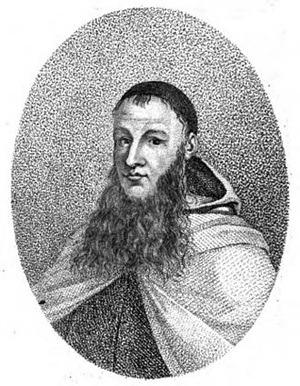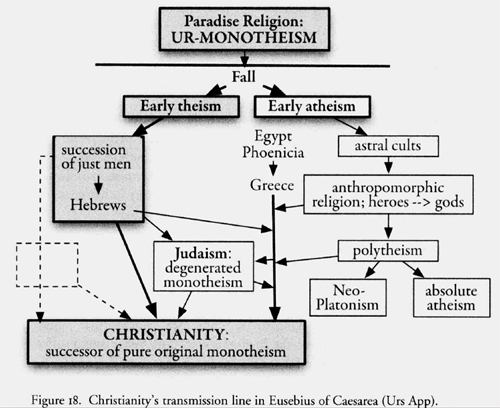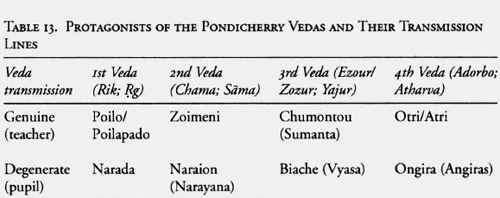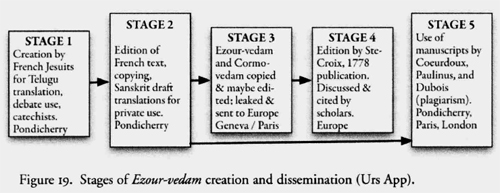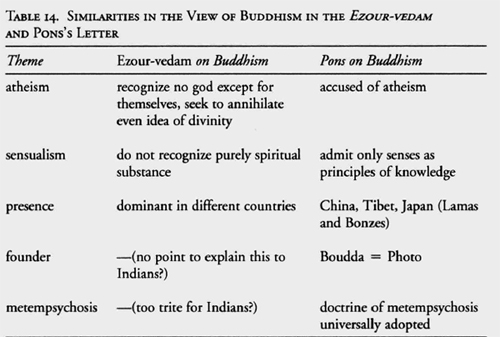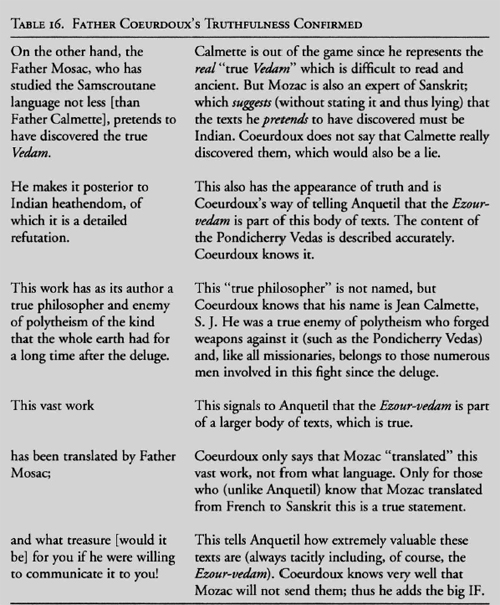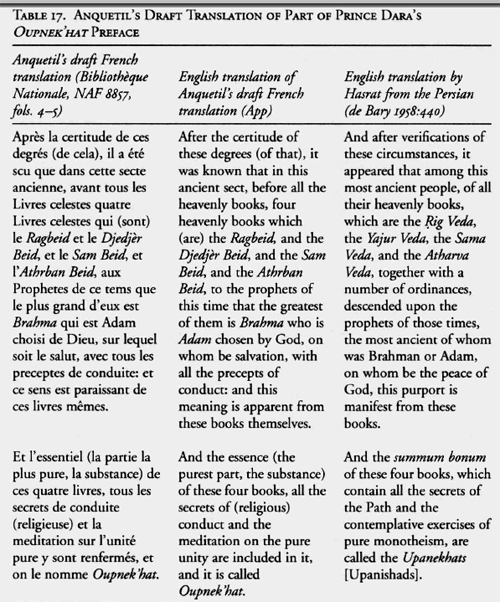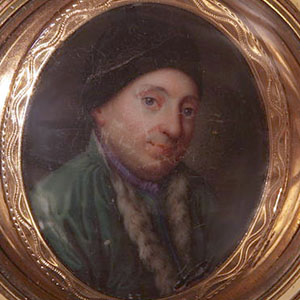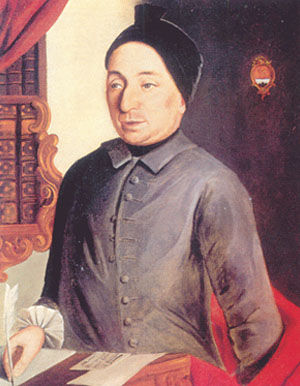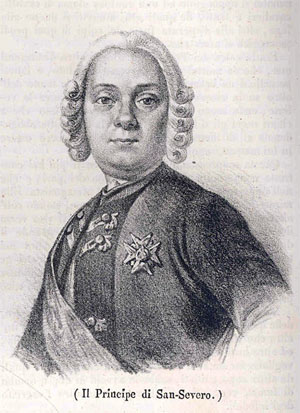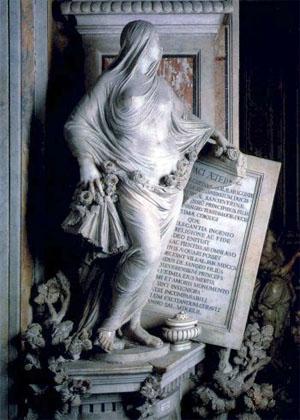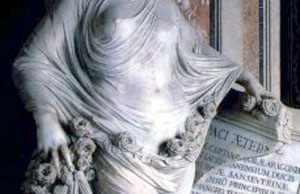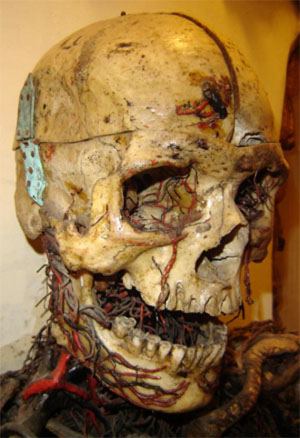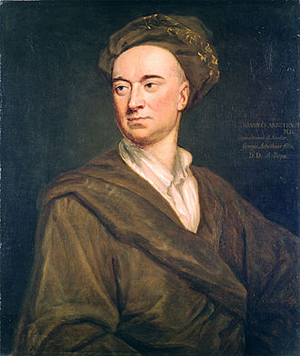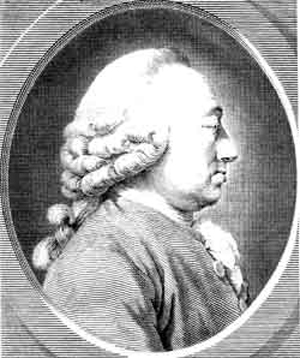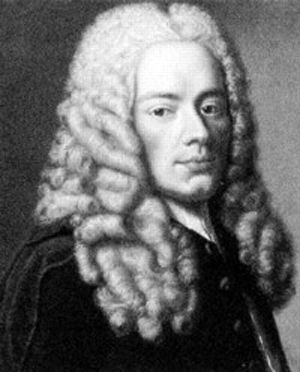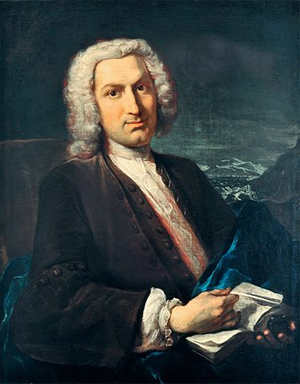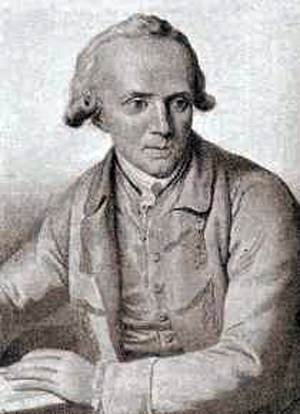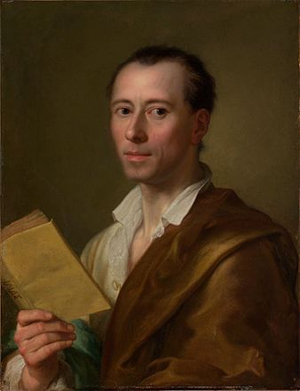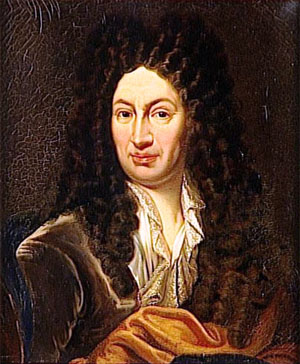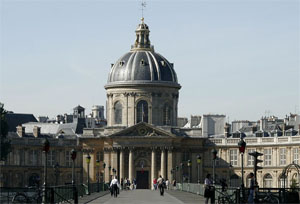Part 3 of 4
Editors and Copyists of the Ezour-vedamWith regard to the time of origin of the Pondicherry Vedas, Ellis reported: "At the end of this manuscript [No.7] are two dates on a slip of paper, on which the concluding lines of the translation are written, one is 'Annee 1732,' the other 'Annee 1751'" (1822:27). Castets, who was the last man to see the Pondicherry Vedas, wrote that in 1923 when he first examined these manuscripts, the slip of paper documented by Ellis had disappeared (1935:33) but commented:
These two dates are interesting in several respects. The second one shows that the Vedams from No. 3 to No. 8 existed in collected and translated form before 1751, as the watermark of 1742 on the paper already sufficiently indicated. We do not talk about the numbers 1 and 2 which were probably much anterior to these latter ones and represented only copies of unknown originals that were evidently written by the French missionaries themselves. Furthermore, these two dates which were written by the annotator of the whole collection, seemed to interest him personally and, by their conjunction, evoke in him emotions of contrast between the interest that he had for these Vedams, or at least some of them, in 1732, and that which his critical inspection of the same inspired in 1751. (Castets 1935:34)
This sounds a bit too emotional, but neither this emotionality nor Castets's absurd conclusion that the Pondicherry Vedas were translations of the forged Vedas bought in 1726 by Pons (p. 46) should distract us from his valuable first-hand observations. He noted that the first two manuscripts -- the Ezour-vedam (whose original tide, Zozur Bedo, was crossed our in red ink and replaced by Ezour-Vedam, p. II) and the Zozochi Kormo Bed (which in Castet's opinion was the Kormo Vedam described by Voltaire; p. 13) -- appeared to be much older than the others and must have been copies of even older originals. Manuscripts 3-8, on the other hand, appeared to be from a later date and were written on paper with a 1742 watermark. In the year 1732, Calmette was in the midst of studying the newly acquired Vedas, and I speculate that the first number on Ellis's slip of paper may refer to the year when Calmette wrote the first texts. By 1735 or 1736, the time of the "broken teeth" event, some texts could well have existed in a Telugu version. After his transfer back to the Malabar mission in 1733, Father Pons might well have collaborated, if the Ezour-vedam's Buddhism passage is a sign; and this would explain some Bengali influence on pronunciation and also the inclusion of information that suggests an author familiar with that region. After Calmette's death in 1739, Pons could have worked on other texts by Calmette and annotated them (if Castets's guess is correct).
I would rather hypothesize that Pons found these texts again on his return to Pondicherry in 1750 and spent his last year reworking them and brushing up his Sanskrit. But possibly other fathers with some knowledge of Sanskrit like Calmette and Mozac also tried their hand at that. The second date noted on that slip of paper, 1751, is the year at whose end Pons died. By this time, all the Pondicherry Vedas probably existed, possibly with partial Sanskrit translations. This does nor mean that they remained unchanged because Father Mozac, as we will see below, had-apart from copying the whole corpus-also added some revisions, and the copying of manuscripts must have continued. The first Ezour-vedam to be brought to Europe was, according to Rocher (1984:86), present in the Harlay Collection by 1755. If this is correct, then only two or three years passed between Pons's death and the arrival of the first Ezour-vedam manuscript in France.
To what degree the manuscript was edited (possibly with the removal of Sanskrit translations and tell-tale signs of its original target public, one of which -- the one with the map-was overlooked) must remain unknown until the vanished Pondicherry Vedas make their reappearance. Bur I would guess that it must have been an inside job by one of the members of the Jesuit mission who looked through the Pondicherry Vedas after Pons's death and between 1752 and circa 1754 prepared two of them, the Ezour-vedam and its Oupo-vedam, the Cormo-vedam, for recycled use on a different target public. It is interesting and perhaps significant that this should have happened exactly when the first volumes of the Encyclopedie appeared in France (from 1751). Was a senior person in the mission, for example, its superior Lavaur or Father Coeurdoux, sufficiently concerned to give the go-ahead for refurbishing these two texts and their recycled use as weapons-only this time against the skeptics and atheists who were about to take over the French information industry? Would this help in convincing them about the existence of original monotheism in ancient India? And might it be an effective weapon against the continuing critique of Malabar Rites?
The rite problem was intimately linked to the idea of original pure monotheism, to the presence of its vestiges in ancient cultures, and to the kind of transmission scheme invented by Eusebius that the Pondicherry Veda's author had adapted for Indian use. If the most ancient religion of India was so excellent and the Ur-transmission of divine revelation to India proven, then it should certainly nor be problematic to let the Indians continue performing some of their ancient rites, should it? The papal bull Omnium sollicitudinum of 1744 had once more confirmed the exclusivist hard line of the Vatican, which gradually grew into a threat not only to the Jesuit mission in the Malabar region bur to the Jesuit order as a whole. It was a situation of crisis because thousands of Indian Christians began to return to their native creed right at the moment when the foundations of the Jesuit order were shaking. During the 1750s, this pressure was building up, and in 1760, there was the first major earthquake: the dissolution of the Portuguese Jesuit mission in India and repatriation of all its missionaries (Launay 1898:I.cxxii). Four years later, King Louis XV signed an edict that ordered "that the Jesuit order shall no more exist in France" (p. 12), and in 1773, the papal bull Dominus ac Redemptor dissolved the entire Jesuit order.
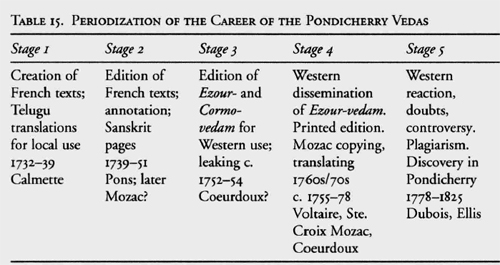 TABLE 15. PERIODIZATION OF THE CAREER OF THE PONDICHERRY VEDAS
TABLE 15. PERIODIZATION OF THE CAREER OF THE PONDICHERRY VEDAS
Stage 1 / Stage 2 / Stage 3 / Stage 4 / Stage 5Creation of French texts; Telugu translations for local use 1732-30. Calmette. / Edition of French texts; annotation; Sanskrit pages 1739-51. Pons; later Mozac? / Edition of Ezour- and Cormo-vedam for Western use; leaking c. 1752-54. Coeurdoux? / Western dissemination of Ezour-vedam. Printed edition. Mozac copying, translating 1760s/80s. c. 1755-78. Voltaire, Ste. Croix Mozac, Coeurdoux. / Western reaction, doubts, controversy. Plagiarism. Discovery in Pondicherry. 1778-1825. Dubois, Ellis.
In the 1750s, time seemed to be running out: the Jesuit mission team was losing the game in India, and the Christian side in Europe began to crumble under the onslaught of rampant secularism, skepticism, and outright atheism. Was the leaking of the Ezour-vedam, to use an American sports metaphor, a Hail-Mary pass? It might well have been. On the other hand, one cannot exclude the possibility that some missionary talked to a countryman in Pondicherry and casually mentioned manuscripts he had found in Father Pons's room, making the Frenchman so curious that he had to lend him a manuscript or two for perusal at home, whereupon the manuscript was copied without permission and sent to Europe as a curiosity. Be this as it may, in the scenario I propose here (see Table 15), there are five different stages that each have their listed main actor but certainly also various co-stars that go unmentioned.
Zoroastrian Victory from the Jaws of Vedic DefeatAfter Anquetil-Duperron's return from India following a five-year stay, he wrote a detailed report about his voyage that was published in abbreviated form in 1762 in French and the following year in English under the title of "A brief account of a voyage to India, undertaken by M. Anquetil du Perron, to discover and translate the works attributed to Zoroaster."15 The Annual Report hails Anquetil-Duperron's journey for the purpose "of extending the bounds of virtue and learning" and calls the Frenchman, who "in so small a period, and in such circumstances, could learn so many languages, utterly unconnected with those already known in Europe, and copy and translate so many books written in them," "a true virtuoso, who braves every danger and difficulty in order to promote useful knowledge, and to increase the materials of speculation in the learned world" (Anquetil-Duperron 1787b:103). However, his chief hagiographer, Raymond Schwab, discerned a rather different heroic enterprise:
If Voltaire wanted from Asia -- in bad faith really -- arguments against the fabrications of revelation, Anquetil hoped -- blindly, for that matter -- to draw from it materials for the confirmation of the dogma, because he was one of those believers in whose eyes the image of the world is divided in two halves, Christians and idolaters. However, the idolaters appeared to him like unconscious depositaries of a tradition that had come from Israel and that was to be recovered. What he wanted to snatch from the Hindus were "the oldest monuments of religion." He went to Asia to seek scientific proof of the primacy of the Chosen People and of the biblical genealogies: but it so happened that his investigations suddenly opened the way to a critique of the books accepted as revealed. (Schwab 1934:4)
We have seen that long before Anquetil-Duperron's trip to India, his early manuscript "Le Parfait Theologien" already showed signs of such critique. Schwab also accepted Anquetil-Duperron's basic narrative about the primary aim of his journey to India as stated in the title of the 1762 report: "to discover and translate the works attributed to Zoroaster."
In 1754, I happened to see a fragment of the Vendidad Sade, which had been sent from England to M. Fourmont,16 and I immediately resolved to enrich my country with that singular work. I formed a design of translating it, and of going with that view to learn the ancient Persic in Guzarate or Kirman; an undertaking which would necessarily enlarge the ideas I had already conceived, concerning the origin of languages, and the several changes to which they are subject, and probably throw a light upon Oriental antiquity, which was unknown to the Greeks and Romans. (Anquetil-Duperron 1787b:104)
This narrative became gospel. While the Encyclopaedia Iranica does not mention dramatic details such as that his only baggage was a small knapsack with "two handkerchiefs, two shirts, a pair of stockings, a mathematics case, a Hebrew Bible, and a copy of Montaigne" and that he left France on a prisoner ship almost like in a scene from Manon Lescaut (Schwab 1934:23-24), it conveys the essence of the myth as historical fact:
After distinguishing himself in classical studies, Anquetil-Duperron went to Holland to study Oriental languages, especially Arabic, with the Jansenists exiled at Amersfoort. Back in Paris, he was appointed to the Bibliotheque du Roi (now the Bibliotheque Nationale). In 1754, he was shown a few lines copied from a fragment of the Avesta brought in 1723 to the Bodleian Library, Oxford, by Richard Colbe. He decided to go to India to retrieve the sacred book, which Colbert, Louis XIV's minister, had ordered Father J. F. Petis de la Croix, a Capuchin, to bring back from Iran without success. In order to hasten his departure he enrolled as a soldier in the Compagnie des Indes and walked all the way to Lorient on the Atlantic in the company of recruits from Parisian prisons. But before embarking on 7 February 1755 he received an allowance of 500 pounds from the Bibliotheque and thus was able to travel as a free passenger. (Duchesne-Guillemin 1987:2.100-101)
However, I found that Anquetil-Duperron already planned to go to India around the end of 1753 -- that is, no less than eighteen months before his departure and before he ever saw the Avesta fragment. He told Abbe Jean-Baptiste Ladvocat "at the beginning of 1754 about the voyage that I counted on making to India," and the Abbe then showed the young man the reports of the Danish missionaries of Tranquebar (Anquetil-Duperron 1771:1.2. ccccxcix).17 This account contradicts Anquetil-Duperron's self-publicized myth that he made this decision in 1754 "on the spot [sur le champ]" (Anquetil-Duperron 1771:1.I.vi).
In the first report after his return from India (1762), he wrote of embarking in 1755 "with a resolution of bringing back the laws of Zoroaster and the Bramins" (p. 105) and added that, before leaving France, he promised "to make myself master of the religious institutions of all Asia" (p. 107). This did not mean that he would study them all, but rather that he would study their common basis: the Vedas. And for this he needed to know Sanskrit:
There is a Samskretam of different ages, and I was desirous of having examples of it thro' all its variations, that I might fix the language in which all the books which are held sacred in that part of Asia which reaches from Persia to China are written. (p. 107)
This gives us a sense of the true objective of Anquetil-Duperron's India adventure. The books that are "held sacred" in most of Asia, from Persia to India and China, and are written in Sanskrit are certainly no Zoroastrian texts. By piecing together information from Anquetil-Duperron's travelogues and letters, one gains the distinct impression that the acquisition and study of the Vedas rather than of Zoroastrian texts was his primary objective and that he later mischaracterized his objectives in order to be seen as having achieved the exact goal that he had proposed. His travelogue is rich in information that disproves the reprioritized narrative that became part of his standard biography. At the very beginning of his stay in Pondicherry, he had the following plan: "After having become familiar with Persian, I wanted to go educate myself in the Malabar region, visit the Brahmes, and learn the Samskretan at some famous pagoda" (p. xxvi). In February 1756, half a year after his arrival in Pondicherry, Anquetil-Duperron was intent on "living from milk, rice, and vegetables in order to be able to afford from my savings the purchase of books and payment of Brahmes of which I planned to become the disciple" (pp. xxix-xxx). He also wanted to devote himself "more freely to the study of Indian books" (p. xxxi) and decided for this reason to travel to the Bengal region. In April 1756 he arrived in Chandernagor, fell ill, and remained for several months in the hospital built by the Jesuit Antoine Mozac, the very man who (probably after joining the Malabar mission) copied all the Pondicherry Vedas. Father Mozac told Anquetil-Duperron about the nearby city of Cassimbazar where he had studied Sanskrit and where several Brahmins resided. Anquetil-Duperron hoped to "stay there for an extended period without toO many expenses" (p. xxxviii). But his illness was so grave that he had to remain in the Jesuit hospital until the fall of 1756. Now more than a year had passed since his arrival in India, and Anquetil-Duperron seriously "thought about renouncing my projects and embracing the priesthood to which I always had been inclined"; even becoming a Jesuit was an option because the order's activity "corresponded sufficiently to the plan for whose execution I had come to India" (p. xxxix). In March 1757, he was still in Chandernagor; around this time he got news from a Frenchman in Surate that the Parsee doctors had "the books of Zoroaster" and were willing to explain it" to Anquetil-Duperron and to teach him the ancient languages (p. xl). Chandernagor being under attack and war in the air, Anquetil-Duperron made a trip to Cassimbazar but "did not find affairs in the state that I had expected" (p. xlii). His passport mentioned his "project in Benares" (p. L) -- which was, of course, to study Sanskrit and translate the Vedas -- but due to the war, this was impossible. It is only at this point that Anquetil-Duperron, fearing for his life and having lost most of his possessions, decided to travel to Surat via Pondicherry to study Zoroastrian texts (p. xlix). This course of events suggests that the principal objective of his voyage to India was not the acquisition and translation of Zoroastrian texts but the acquisition and translation of the Vedas. Not the Zoroastrian texts but the Vedas seemed to be the key to "all the religious institutions of Asia." But why was young Anquetil-Duperron so convinced that the Vedas contained "the sacred laws of all of Asia" (Anquetil-Duperron 1771:I.2.ccclxiv)?
Freret, de Visdelou, and DeshauterayesThrough his employment at the Royal Library, before his India journey, Anquetil-Duperron came into contact not only with Deshauterayes, who showed him the famous Avesta fragment, but also with Fourmont's other disciple Joseph de Guignes. In the year 1753, at whose end Anquetil-Duperron decided to go to India to study Sanskrit and the Vedas-and thus to acquire the key to the sacred laws that anciently reigned in all lands between Persia, India, and China-there were several events of importance for Paris orientalists. One was de Guignes's presentation on July 24 at the Royal Academy about the Samaneens. De Guignes claimed that the Brachmanes and the Samaneens were in fact two sects of one religion that he called "la religion Indienne" (the Indian religion). This religion had metempsychosis as its central tenet and regarded the Samaneens as the ultimate stage of purification (see Chapter 4). But de Guignes left open many questions regarding the history of this religion and its relationship to the Vedas.
The idea of an Indian religion reigning in most of Asia was, as we have seen, rather old. But it had gained new relevance through Johann Jacob Brucker's multi-volume history of philosophy (Brucker 1742-44) and through the ideas of an erstwhile rival of de Guignes's and Deshauterayes's teacher Fourmont. This man was Nicolas FRERET(1688-1749), famous as the first Frenchman in Paris to study Chinese and even more as an expert on chronology and ancient history.18 In the last years of his life, Freret showed acute interest not only in the chronologies of Asia but also in their religions, and on February 7, 1744, he presented some findings to the Royal Academy that he planned to include in a book. But this book never appeared, and four years after Freret's death, a summary of his 1744 presentation was published under the title of "Researches on the religious and philosophical traditions of the Indians, to serve as preparation for the examination of their chronology" (Freret 1753:34). Freret not only thought, like many others, that "the Indian religion is very widespread in the Orient" but also spoke of two major branches. The first branch is "the religion of the Brahmes which encompasses almost all ancient inhabitants of the lands between the Indus and the Ganges," and the second branch consists of the religion "dominating the region to the North and East of the Ganges" as far as Tibet and Bhutan. This second branch of Indian religion is the one that "the Chinese have adopted in the year 64 of the Christian era and is also dominant in Japan" as well as Vietnam, Laos, Cambodia, Burma, and other Asian countries (p. 36).
Freret's second branch of "Indian religion" clearly refers to what we today call Buddhism, and in his 1744 presentation to the Academy, he emphasized the importance of scientific research and language study to gain a better understanding of this religion that appeared to be the largest in the world. Like de Guignes a decade later, Freret sought to associate specific sacred texts with this "branch." Instead of the Anbertkend and the Forty-Two Sections Sutra that de Guignes in the 1750s was to regard as foundational for this widespread branch of Indian religion, Freret opted for the Vedas. Since the Vedas were not available to him, he relied -- like Holwell after him -- on the report about their content in the sixth book of the Decada Quinta of do Couro (see Chapter 6). Freret quoted do Couro's assertion that Indian religion has a creator God named Scharoues Zibari, who is surrounded by pure spirits who contemplate him (p. 38). Unlike Holwell who interpreted Couto's good spirits as angels serving God, however, Freret connected them with the quietist notion of supreme beatitude. In his view this state corresponds to "what the Siamese call Niveupan, the Peguans Niban, the Japanese Safene, and the Chinese Coung-hiou" (p. 38).19
Freret thus relied on the reports by Couto, Roger, and Baldaeus for the first "branch of Indian religion" -- the one that dominates the Indian subcontinent-and the descriptions by de la Loubere, Pierre Bayle, La Croze, and others for the other "branch" that dominated most of the rest of Asia. He weaved all this into his portrait of a gigantic religion that worships God in the form of Vishnu. Since he had read that Buddha is an incarnation of Vishnu, which marks the beginning of the fourth world age, the link between these two branches seemed obvious. Freret explained:
We omit here all that concerns the eight previous apparitions of Vishnu that do not belong to the present historical period. In the ninth [apparition] which belongs to our age, he came on earth in human form. In the Indies and on the island of Ceylon he is called Boudhe or Boudhan; in Siam Ponti-tchaou which is the same as Sommonacodon, translated in de la Loubere's report as Talapoin of the woods. In China he is called Po or Fo or according to Portuguese orthography Foe, and sometimes Chekia or Chaka. The Japanese honor him under the title of Amida;20 this is throughout Vishnu under different names. (p. 44)
Freret's report that was published in 1753, the year of Anquetil-Duperron's decision to travel to India, presented this "Indian religion" as "an extremely ancient system in the Indies" that radiated far toward East and West. He saw clear traces of it in the system of Pythagoras, and even "Plato adopted a part of Indian ideas." They also found their way into Christianity through Origen who "pretended to adapt them to Christianity" (p. 45). Freret was convinced that "the Indian religion, like all the others, had at its origin the primary truths that are generally known by all men and that form the body of natural revelation that is as old as the universe" (p. 45). This view of "Indian religion" was surprisingly long-lived and influential. For example, in 1777, the huge Dictionary of Classical Authors furnished under the heading "The religion of the Indians" exclusively information from Freret's summary, adopting it almost word for word (Sabbathier 1777:22.241-26).
But Freret's vision also deeply influenced de Guignes, Deshauterayes, and young Anquetil-Duperron. From Freret's viewpoint, there was nothing more urgent than the study of the Vedas. They had to contain not only the basis of the subcontinental "branch" of India's religion but also the second branch that we now call Buddhism. The Vedas were thus most likely to furnish the "key" that young Anquetil-Duperron had in mind when he wrote of making himself "master of the religious institutions of all Asia" through the study of ancient Sanskrit texts (Anquetil-Duperron 1787b:107). Exactly because he, like Freret and de Guignes, thought that the religious traditions of the Indian subcontinent and most other Asian countries had the same "Indian" root, he thought of China as a possible avenue for information about it. Unable to gain access to the Vedas even after four years in India, Anquetil-Duperron planned to travel via Tibet to China where he hoped to find ancient Indian texts that the Brahmins or polomen might have brought there.21 So he wrote two letters to the Jesuit Antoine Gaubil in Peking (who had been recommended to him by Deshaurerayes) to inquire about this. Though Anquetil-Duperron's letters are no longer extant, Gaubil's response forms part of Anquetil-Duperron's manuscript dossier at the Bibliotheque Nationale in Paris:22
I have received five days ago the letter that you made me the honor of writing from Goa on 20 March of 1758, [but] I have not received the one you said you wrote from Pondicherry. The polo men or brahmes came to China from the Indies more than 1600 years ago. More than 1300 years ago several Chinese put them into Chinese characters and in a Chinese language. What they learned from the polomen about the religion, astronomy, geometry, etc. -- these books are lost, and what remains consists only of a few truncated and confused fragments. The Chinese bonzes then took care to translate into Chinese the Indian doctrine, and in their prayer books, etc., they transcribed in Chinese characters many terms and phrases that nobody understands.23 ... If you execute your plan to come to China by way of Tartary, you will have quite some expenses to incur, quite some obstacles to overcome, and more than once you will be in need of heroic patience. Add to this many life-threatening dangers.
To judge from Father Gaubil's letter, Anquetil-Duperron was discouraged by Brahmin unwillingness to teach foreigners Sanskrit and was intent on finding materials in Chinese for the study of Sanskrit and ancient Indian doctrine. But Gaubil informed him in a postscript: "Even if in the past the Chinese have learned the rules of the Sanscroudang [Sanskrit] by way of the polomen, one does not find these books at all, and I do not believe that there is someone who would have read such [books]."
Thus, Athanasius Kircher's and Claude de Visdelou's ideas of Brahmin missionaries in the Fat East teamed up with Freret's two-branched Asian monotheism to form a powerful motive for the search for ancient texts of "Indian" religion in countries other than India. But there was yet another hidden avenue of de Visdelou's influence on Anquetil-Duperron. On October 8, 1755, his mentor Deshauterayes wrote a long letter to India to inform the young man about several issues of interest.24 He sent Anquetil-Duperron a reading list of literature about Indian religion (NAF 8872:70r) in which he particularly recommended books by Abraham Roger and La Croze. With regard to languages, Deshaurerayes insisted that "one must learn the language of a people of which one wants to speak and critically read its writings" (p. 73r) and recommended the study of the "Baly [Pali] language which is the only language of the Indies, along with the Tibetan, that I strongly exhort you to learn" (p. 70v). Deshauterayes had told Anquetil-Duperron before his departure for India about an unpublished paper about the Samaneens that he had written. In the letter, Deshauterayes informs his protege about some of its content. One passage in particular attracted my attention when I first read it. Deshauterayes informs Anquetil-Duperron that the Samaneens are monotheists worshipping a God called Aruguen and teach everywhere moral virtues and the transmigration of souls:
The God Aruguen whom they worship has given the Vedam, which is why he is called adi Veden the legislator, and Veda-niden, the Lord of the Law. These titles are also attributed to Vichnou by his devotees; but there is nothing surprising about this because, for the Indians, the ninth incarnation of Vishnu was in Boudha, and Boudha, I believe, is not different from Aruguen. One still gives to this God Aruguen the epithet of Siva cadigu'irveiven, that is, Lord of the glory of God Shiva, and that of Puten which I believe derived from the term Boudha. (p. 70v)
Deshauterayes had a very similar argument printed more than twenty years later in 1778:
Arugen, the god of the Samanes, is the same as Boudha; he has given the divine law of the Vedam, and this is why he is called Adi-veden, the first legislator, Veda-niden, the lord of the law; titles which are also attributed to Vichenou by his devotees, which is not surprising because, according to the Indians, Vichenou in his ninth incarnation became Boudha, and Boudha seems not at all different from Aruguen. (Mailla 1778:5.52)
These "Samanes" who believe in Buddha = Aruguen appear to be monotheists of the purest kind whose religion is very ancient. The following passage is not in the letter of 1755 but clarifies Deshauterayes's view of these pure ancient monotheists:
The Samanes are probably as ancient in the Indies as the Brahmes and have left many monuments of their genius, had a religion which was not different from that of the Gymnosophistes and knowledge of an infinitely perfect being that they called Aruguen and to whom they gave the most excellent attributes. They call him god of virtue, pure, infinite, eternal god, immovable, very wise god, very kind, very powerful, etc. They add that he reigned happily in the heavens in the shadow of a tree Asogu or Pindi. Since the Samanes completely neglected the cult of other gods in favor of Aruguen, they were usually called Aruguer; but those among them who distinguished themselves through their spirituality and the sanctity of their life were called Saraner. (p. 51)
Deshauterayes clearly thought that the sectarians of Buddha are monotheists; that they are no different from Vaishnavas; that the Veda is their sacred scripture; and that the Veda is a thoroughly monotheist text revealed by the god Buddha = Vishnu = Aruguen. I kept wondering where Deshauterayes got these ideas and words like Adi-veden from, until in the summer of 2008, I went through the papers of a De Guignes folder25 at the Bibliotheque Nationale. Someone wrote in small letters on the cover sheet: "These papers were mixed with those of Fourmont. One can, on account of the handwriting and their content, attribute more or less all of them to De Guignes." Only the first sheet is dated "3 May 1754"; it is an introduction to the history of the Samaneens. On page 4 begins a long document titled "Letter from Pondicherry. On the Sammaneens" which on page 7V has the following familiar passage:
The God Aruguen worshiped by the Sammaneens is also called Puten. One gives him also the epithet of Siva cadigu 'irveivem, that is, Lord of the glory of God Chiven. They say that this God Aruguen gave the divine Law or Vedam: that is why he is called Adi veden, that is first legislator, and vedaniden, the Lord of the Law: yet it is true that these names are also given to Vichnou by his devotees.
 Deshauterayes letter to Anquetil / Copy of Pondicherry letter. Figure 20. Handwriting comparison of NAF 8872 and NAF 279.
Deshauterayes letter to Anquetil / Copy of Pondicherry letter. Figure 20. Handwriting comparison of NAF 8872 and NAF 279.The dossier contains a fragment of one more letter from Pondicherry (pp. 11r-12v), and the content of both letters indicates that there must have been a total of three letters written by a French-speaking missionary in Pondicherry. The first letter cites La Croze and was thus written after 1724. The third letter cites Engelbert Kaempfer and was thus written after 1729. The writer could read Chinese (he cites Ma Duanlin and various Chinese texts) and was familiar with Indian terminology. He also knew southern Indian literature and criticized a text dating by the Danish missionaries. And, of course, the writer of the letters resided in Pondicherry in the early 1730s, just around the time when Calmette wrote the Ezour-vedam. Given these data, the only author I can think of is Claude de Visdelou, who died in Pondicherry in 1737. The letters were thus probably sent to Paris between 1730 and 1737. The addressee is unknown (he is once called "mon cher Osman"), but there is little doubt that the precise references to Chinese texts were meant for Fourmont and that someone had copied parts or all of these letters. The copied first letter and part of the third letter somehow ended up in Fourmont's files at the Bibliotheque Nationale, and later someone decided that they are from de Guignes, which is why they ended up in his dossier (NAF no. 279).
However, a handwriting comparison (see Figure 20) shows that the copyist of these letters from Pondicherry was Deshauterayes and not de Guignes.26 Deshauterayes' quotations from de Visdelou's letters in his missive to Anquetil- Duperron show, as does his note in de Mailla's history, that he was just as good as his rival de Guignes and their teacher Fourmont at plagiarizing the writings of missionaries. Having copied these Pondicherry letters, Deshaurerayes used parts of them in his letter to Anquetil-Duperron as if these were his own findings, adding "I believe" and "I concluded," etc., to de Visdelou's text! He also asked Anquetil-Duperron to find out some things that he found intriguing in de Visdelou's letters, for example, the identity of the Parajacechatam sect that supposedly destroyed the sect of the Sammaneens in India (NAF no. 8872=72). The Pondicherry of the 1730s was a truly amazing hub of information!
Abbe Mignor's BlueprintOn March 14, 1762, Anquetil-Duperron returned to Paris after a stay of nearly six years in India, and the next day he deposited his manuscripts at the Royal Library. In June his report appeared in the Journal des Sravans, and he became an instant celebrity. The tide of his report indicated that he had gone to India "to discover and translate the works attributed to Zoroaster." At age 31, Anquetil-Duperron was hailed in the Annual Register as a "a true virtuoso" who braved "every danger" for the sole purpose of increasing "the materials of speculation in the learned world" (Anquetil-Duperron 1787b:103). Just after the publication of his report, he was invited to a dinner where he saw de Guignes again and also met a guest who had the distinction of being Voltaire's nephew and a very erudite man: Abbe Vincent MIGNOT. That very month Mignot was reading his fourth paper on the ancient philosophers of India at a session of the Royal Academy, and there can be no doubt that Anquetil-Duperron artended it. Mignot had read the three earlier papers while Anquetil-Duperron was preparing for his return or was on his way back to Europe.
Mignot's first paper, read on February 27, 1761, had dealt mainly with the question of whether the Egyptians had influenced the Indians or vice versa. Mignot concluded that Buddha, who is considered the father of Indian philosophy, lived about 1000 B.C.E. and that this makes his religion too ancient to have been influenced by Greeks or Egyptians (Mignot 1768:81-113). The second paper, read on June 2 of the same year, showed that features of Indian religion that were considered to be of Egyptian origin (transmigration, lingam and cow cult, and such) could be explained without Egyptian influence and that La Croze's and Kaempfer's ideas about the Egyptian origin of Buddha's religion were built on sand because the association of Buddha and Mercury with Wednesday is much younger than they had believed (pp. 114- 52). The third paper rejected early Egyptian influence on India by arguing that there simply was no commercial or other link between the two countries at such an early point (pp. 153-211).
For someone like Anquetil-Duperron who did not believe in the theories of Egyptian origins that were so fashionable among collaborators of the Encyclopedie, these three papers (which he might have read only in 1768 when they were printed together with numbers 4 and 5) were less interesting than the last two of Mignot's lectures that he could actually attend. Mignot continued to discount early Egyptian influence on India. In the fourth paper, read on June 15, 1762, he mainly sought to show the differences-all in India's favor -- between a number of Indian and Egyptian religious doctrines. With respect to strict monotheism, for example, Mignot regarded the Indians as fat superior to the Egyptians. Citing do Couro, La Croze, Francois Bernier, and also Indians' letters to Ziegenbalg, Mignot found that even the "successors of the ancient Brachmanes are intimately persuaded about the unity of God"; and so is "the sect of Gnanigueuls who are regarded as the sages and saints of India." They reject openly the "cult of idols and all superstitious practices of the nation in order to worship only God whom they call the being of beings" (p. 219). The Buddha, too, was called upon for the support of Indian monotheism:
It is to express this perfect simplicity of God that Budda, the author of Indian philosophy, when he explained his true feelings to his dearest disciples, told them that the principle and end of all things was emptiness or nothingness [le vide ou le neant]; this nothingness or this emptiness was, according to his doctrine, a real being [un etre reel] because he gave it attributes and taught that it was admirable, pure, infinite, and the principle and perfection of all beings. By calling it empty or nothing [vide ou neant] he adapted himself to the conventions of common people [vulgaire grossier] who use the term "nothing" for anything that has no coarse parts, does not fall, or is not perceived by its senses. The disciples of these philosophers, who remained faithfully attached to the doctrine of their master, recognize until today that God is a pure spirit and an infinite immaterial intelligence; this is how they put it in the comprehensive theology that was given in Couto, the continuator of Barros; and in one of their books entitled Panjangam, which is their almanach, one reads this prayer: I adore this being whose nature is indivisible, and whose simplicity does not admit any composition of qualities. (pp. 224-25)[/quote]
The five papers Mignot read at the Royal Academy, and particularly the fourth and fifth whose presentation Anquetil-Duperron could attend in person, were almost like a blueprint for Anquetil-Duperron's further work on India. Both men were convinced that India and its Vedas had preserved the most complete vestiges of man's Ur-religion, opposed the encyclopedists's ideas of Egyptian origin, and somehow wanted to build their Indian Ur-religion on the bedrock of the main events and chronology described in the book of Genesis. In the "triangle of origin narratives," the biblical corner was still dominant and very crowded. In exchange, the Egyptian corner could boast of some famous names of intellectuals and encyclopedists. The Indian corner was at this point still almost empty, but in the 1760s, the situation began to change. Merely four decades later, Friedrich Schlegel was to write enthusiastically in a letter: "alles, alles stammt aus Indien, ohne Ausnahme" [Everything, everything comes from India, without exception]" (Schlegel 1864:3.329). The Ezour-vedam's deposition at the Royal Library, Voltaire's 1761 edition of the Essai sur les moeurs with its stunning vista of an Indian origin of civilization, Abbe Mignot's India papers with their monotheistic Buddha, and Anquetil-Duperron's return from India all seemed to ring in a new era. Long before the beginning of the European colonial domination of India, "Indian religion" was seen as a pan-Asian phenomenon with "Brahmanic" and "Buddhist" branches. Diderot and many others thought it had Egyptian roots and associated it with polytheism, idolatry, atheism, materialism, or fatalism. But a second major line of interpretation was gathering steam in the 1750s and 1760s. Inspired by Brucker,27 Freret, de Guignes, and Mignor, it interpreted even the Buddha's "inner" teaching of emptiness and nothingness as a (possibly degraded) vestige of ancient monotheism and identified Asia's dominant "Indian religion" with humankind's universal, god-given ancient theology. At the beginning of the nineteenth century this became one of the core ideas of the indomaniac Romantic age in which Anquetil-Duperron's translations played a key role. But in the 1760s, when Voltaire and Holwell peddled their "proofs" of ancient Indian monotheism, this second line of interpretation was still in its infancy.
The Holwell ShockWhat bothered both Mignot and Anquetil-Duperron was that there were descriptions of the Vedas bur hardly any translated material. Instead of being able to quote the Vedas themselves, Mignot had to rely on bits and pieces from do Couto, Jesuit letters, communications by Danish missionaries, Roger, La Croze, and, of course, the newly arrived Ezour-vedam. But this text was no Veda either but rather a commentary by someone who criticized the Vedas. On August 27 of 1766, Anquetil-Duperron received a visit of Antoine Court de Gebelin from Geneva who told him about another copy of the Ezour-vedam brought back from Pondicherry by a Mr. Tessier (Rocher 1984:8). From this manuscript, Anquetil-Duperron made his own copy and noted that it had a chapter at the end that was missing in Voltaire's copy. In the margins of his copy, he made several remarks that are signs of frustration. He would have liked to see Vedic quotations; but instead of citing textual authority, Chumontou keeps appealing to reason. One of Anquetil-Duperron's comments reads:
This is how the Br[ahman] Chumontou proceeds. Later in this treatise he refutes the legends told by Biache, either because they are contrary to good sense, or because they are not found in the ancient books, and he provides a moralistic explanation for those that are based on facts which he agrees to. However, these legends are accepted throughout India (see Abrah. Roger), and Chumontou does no more than confront them with the doubts of a philosopher which cannot be held to represent the religion of India. To prove that they are, he ought to combat authority by authority. (Rocher 1984:8-9)
But soon afterward, in 1767, a sensational translation of an ancient Indian text arrived in France: Holwell's Shastah. It created quite a stir and was almost immediately publicized by Voltaire and published in French (1768). A major reason for the commotion was its introduction, which presented a four-stage genealogy of India's sacred literature, claimed that the "Vedam" was used only in southern India, and called it a late and degenerate source that was absolutely inferior both in age and quality to the Shastah presented and translated by Holwell (see Chapter 6). The matter bothered Anquetil-Duperron so much that he bought a second copy of the French edition of Holwell's book and sent it to Father Antoine MOZAC (1704-C.1784) in India asking for his opinion. In his parcel he also included the Royal Academy volume containing Abbe Mignot's five papers.
Anquetil-Duperron was full of big questions, but in his letter to Gaston Laurent COEURDOUX(1691-1779) that was included in the same package, he played down their scope: "I would like to ask you two small clarifications about matters that you surely know perfectly. The first is about the nature of the Paraparavastou, the supreme Being, the first cause in Indian theology; and the second concerns the nature, origin, and antiquity of the Vedams, or Vedes, Beids. We would be very interested in seeing what you have collected about this" (Anquetil-Duperron 1808:672). His letter to Fr. Mozac, who had studied Sanskrit and given Anquetil-Duperron advice about this while he was for many months at the mission hospital at Chandernagor, was more explicit. Since his stay at Chandernagor, he had never contacted Mozac again, but now, eleven years later, he was desperate: everything he thought he knew about the Vedas had been torpedoed by Holwell's stunning assertions.
Holwell had, in fact, been second in command at Cassimbazar, the very city where Mozac had studied Sanskrit and where Anquetil-Duperron had wanted to follow in Mozac's footsteps. There was this strange link between the fate of Holwell, who apparently had managed to learn from the Brahmins at Cassimbazar, Mozac who had studied Sanskrit there, and Anquetil-Duperron, who had wanted to do the same but ended up having to embrace what really was h is second choice, namely, the study of Zoroastrian texts. "It seems that his plan is to elevate the Indian religion above all other known religions," he wrote to Mozac about Holwell, "and if his work presents some exceptions in favor of Christianity, one sees well that they are only due to the author's profession of this religion" (p. 675). Anquetil-Duperron had carefully compared the French translation to the English original and noted some translation mistakes in the margins of the copy he sent to Father Mozac. He also sent a list of contradictions that he had noted: Holwell's claim that this religion is purely monotheistic, while the text contains numerous examples of polytheism; various problems in the relationship of God and the Trimurti; strange contradictions with regard to Holwell's angels; the list goes on (pp. 675-76). Anquetil-Duperron's most urgent questions, however, concerned the relationship between Holwell's Shastah and the Vedas:
The fourth point that strikes me as particular about M. Holwell is that he reports, based on the words of Brahmes, about the origin of the Vedam which he makes younger by 1,500 years than the Chartah Bhade Shastahs of Brahma. First of all, it seems to me that one should have written schastra and not schastah. In malabar schastiram, in telougou schastram signify science, doctrine; and under this name is comprised what is in the Vedam. Second, the author distinguishes the Bhades from the Vedam; yet I find nothing in the books at my disposal that authorizes this distinction. (p. 677)
Anquetil-Duperron had never heard that the Vedas are only used in the south and the Shastah in the north and wondered how this was compatible with the description of the Vedas by do Couto (p. 677). Another doubt he presented to Father Mozac concerned Holwell's angels. Noting that do Couto had also described the second class of higher intelligences as prisoners in bodies that are on earth for purification, he asked Mozac, "Are these ideas about metempsychosis taken from ancient books of the Indians? Is what the author says about the fall of the angels and the apparitions of good genies on earth really found in the text that he calls the Schartah Bhade of Bramah?" (p. 678).
Anquetil-Duperron also felt that Holwell's ideas about metempsychosis were contradicted by Indian animal sacrifices. To make sure that Father Mozac's reply would cover his major doubts, he added a summary at the end with the title "Questions to clarify":
1. About the first principle recognized by the Indians; about Bram, Birmah; the allegorical explanations, etc.
2. On the origin and the nature of the Vedes or Bhades or Vedams;
3. On the fall of the angels, the origin of metempsychosis, and the [origin of] the custom obliging women to burn themselves, etc.
4. About bloody sacrifices in use or not with the Indians; the Sanskrit dictionary mentions sacrificial horses. (p. 680)
These were indeed good questions, but Father Mozac never responded. While Anquetil-Duperron finished his Zend Avesta translation and prepared it for publication, two other works with translations of Indian texts came to his attention: Dow's History of Hindostan (1768) and the manuscript of Maridas Poulle's Bagavadam translation that he could borrow for two or three days in 1770 (Anquetil-Duperron 1787a:2.64).
In February 1771, Coeurdoux at last responded with a gentle criticism of Abbe Mignot's idealization of Indian religion and his misunderstanding of the lingam cult and wrote that Abbe Mignot might profit from "following in the footsteps of another scholar and spending a few years in India" while promising, should he do that, to show him "the unity of God and the great event of the deluge in the Indian books" (Anquetil-Duperron 1808:49.68[- 82). He also responded to Anquetil-Duperron's central question about the Vedas:
I must now respond to your questions about the Vedams. We name them in Telugu and in the Samscroutane script of this region, Sama vedam, Ezour vedam, Roug vedam, Adharvana vedam. Several people say that this last Vedam is lost; I believe nothing of it. It is, one is assured, a book of magic; and this sort of books least of all gets lost in a heathen country where there are people everywhere who play themselves up as magicians. I saw a book of magic secrets that began with the first lines of the Adharvana vedam; but there was nothing more ... There are Brahmes of every Vedam, and each knows of which Vedam he is. Does it seem possible that those of the fourth could have permitted theirs to get lost? (pp. 684-85)
But now Coeurdoux added two remarks that not only confounded Anquetil- Duperron but puzzled many readers, including this writer:
I will add here what I have heard Father Calmette-who knew the samscroutam [Sanskrit] and had much studied the books of Indian science -- utter more than once: that the true Vedam [le vrai Vedam] is of such an ancient samscroutam that it is almost unintelligible, and that what one cites is of the Vedantam, that is, of introductions and commentaries that were made of the Vedam. In effect, in a famous prayer named gai'tri, one understands only the word savitourou, the sun. (p. 685)
But it is the remark that immediately follows that led to accusations of lies and deception. Since this is a crucial passage, I quote also its original French:
D'un autre cote, le P. Mosac, qui n'a pas moins etudie la langue Samscroutane, pretend avoir decouvert le vrai Vedam. II Ie fait posterieur a la gentilite Indienne, dont il est la refutation detaillee. Cet ouvrage a pour auteur un vrai philosophe ennemi du polytheisme, tel que toute la terre en eut long-temps apres le deluge. Ce vaste ouvrage a ete traduit par le P. Mosac; et quel tresor pour vous, s'il vouloit vous le communiquer.
On the other hand, the Father Mosac, who has studied the Samscroutane language not less [than Father Calmette], pretends to have discovered the true Vedam. He makes it posterior to Indian heathendom, of which it is a detailed refutation. This work has as its author a true philosopher and enemy of polytheism of the kind that the whole earth had for a long time after the deluge. This vast work has been translated by Fr. Mosac; and what treasure [would it be] for you if he were willing to communicate it to you! (p. 685)
Coeurdoux's juxtaposition of two "true" Vedas is breathtaking. He clearly takes the side of Fr. Calmette, who talked about the difficulty of the Veda's language and about its Vedanta commentaries. The second "true" Veda, by contrast, seems to be genuine only for Father Mozac who pretends to have discovered it and makes it posterior to heathendom. Yet Coeurdoux lauds Mozac's Veda author as a true philosopher and enemy of polytheism and calls it a vast work that Father Mozac has already translated.
Anquetil-Duperron, who added some comments on other pages of this letter, did not write anything in the margins of this page. But in the printed version of 1808, he explained in a note, "This work must be the Ezourvedam" and added a reference to his Zend Avesta (where he first quoted the Ezourvedam) and to the printed edition by Sainte-Croix of 1778.
It is clear that Coeurdoux, who had attentively studied Mignot's articles and provided some detailed criticisms, knew that the Ezour-vedam was in the Royal Library in Paris and that it was now used and cited by academics like Mignot. What he probably did not know was that Voltaire had sent it there; Mignot had mentioned only the librarian's name. This remark about Mozac's Veda was not in answer to any question, since Anquetil-Duperron had written nothing in his letters about the Ezour-vedam. Coeurdoux clearly was in the loop about the content of Mozac's Veda because he knows that it is "a detailed refutation" of Indian heathendom written by "a true philosopher and enemy of polytheism." We must therefore assume that the reason why Coeurdoux even mentioned Mozac's Veda and described it in a way that would immediately point to the Ezour-vedam was linked to his knowledge that the Ezour-vedam was making waves in educated Paris.
Had Coeurdoux known at this point that it was being used by Voltaire for his anti-Christian propaganda campaign, he would very likely have kept mum; he could have mentioned some information about the real Vedas and left it at that. But he decided, for some intriguing reason, to advertise Mozac's Vedas in such a manner that Anquetil-Duperron was certain to associate it with the Ezour-vedam. Not only that: he wanted Anquetil-Duperron to think that it is a genuine, though later text than the Veda described by Calmette and that it forms part of a different Vedam. There is no doubt that he must have anticipated that this unsolicited remark about a "vast work" in the generous hands of a missionary (who for many months had taken care of Anquetil-Duperron at me Chandernagor hospital and almost drew him into the Jesuit fold) would provoke me curiosity of the researcher who, as Coeurdoux knew, had been passionately chasing after the Vedas for years. There was no doubt that Anquetil-Duperron's next letter would bring a demand for this "vast work" that Coeurdoux dangled so conspicuously in front of the seeker of Ur-monotheism.
This is exactly what happened. In his reply of February 8, 1772, Anquetil-Duperron wrote again to Coeurdoux because Mozac never responded, and he made an attempt at flattering the silent father:
Even though the Father Mosac has not honored me with his response, I do not doubt for a minute of his friendship for me and that the communicative character that I know him to have will cause him to share with us his important research on the languages, the history, and the mythology of North India. We wait, among other works by this erudite missionary, for the translation of what he calls the true Vedam, which includes the refutation of polytheism. We count on Father Mosac to join the original to his translation and to accompany this precious treasure, as you justly call it, with critical discussions of the nature, author, and age of this Vedam, the country in which it was composed, and the regions where it is the law in preference to the four Vedas accepted on the Malabar coast, Coromandel, the Gujarat, etc. (p. 688)
Anquetil-Duperron also made a connection that Coeurdoux might not have anticipated: he suspected that the Vedam of Father Mozac was the corpus of texts that contained Holwell's Shastah!
Father Mosac has worked in Bengal, like Mr. Holwell; the one close to Cassimbazar and the other in Cassimbazar itself. Both speak of a Vedam or Bhade that is different from the four that we know: the Bengal and me neighboring countries seem the only regions of Hindostan where this Vedam is current. (p. 688)
But no amount of pleading could budge Father Mozac who never responded with a single word and did not even thank Anquetil-Duperron for the books he kept sending at great expense. Coeurdoux explained this silence as follows:
I have read to Father Mozac the part of your letter which regards him. My eloquence, combined with yours, has been useless to persuade him to communicate his vast and erudite collections. (p. 690)
This was the last word Anquetil-Duperron heard from the Pondicherry missionary about this question; after this, he never received another letter.
